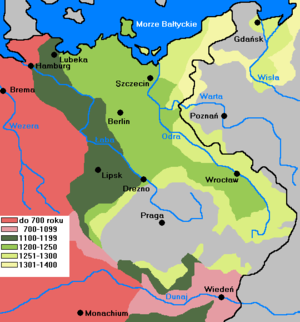
Wends is a historical name for Slavs who inhabited present-day northeast Germany. It refers not to a homogeneous people, but to various peoples, tribes or groups depending on where and when it was used. In the modern day, communities identifying as Wendish exist in Slovenia, Austria, Lusatia, the United States, and Australia.

The Duchy of Saxony was originally the area settled by the Saxons in the late Early Middle Ages, when they were subdued by Charlemagne during the Saxon Wars from 772 and incorporated into the Carolingian Empire (Francia) by 804. Upon the 843 Treaty of Verdun, Saxony was one of the five German stem duchies of East Francia; Duke Henry the Fowler was elected German king in 919.

Koos is the largest of several small islands in the Bay of Greifswald, Mecklenburg-Vorpommern, Germany. It has an area of 772 hectares and a maximum elevation of just above three meters. The island is a largely uninhabited natural reserve with restricted access. It is separated from the mainland by Kooser Bucht and Kooser See, two bays connected by a tiny strait, Beek.

Polabian Slavs, also known as Elbe Slavs and more broadly as Wends, is a collective term applied to a number of Lechitic tribes who lived scattered along the Elbe river in what is today eastern Germany. The approximate territory stretched from the Baltic Sea in the north, the Saale and the Limes Saxoniae in the west, the Ore Mountains and the Western Sudetes in the south, and Poland in the east.

Eastphalia is a historical region in northern Germany, encompassing the eastern Gaue (shires) of the historic stem duchy of Saxony, roughly confined by the River Leine in the west and the Elbe and Saale in the east. The territory corresponds with modern southeastern Lower Saxony, western Saxony-Anhalt, and northern Thuringia. Together with Westphalia, central Angria, and Nordalbingia, it was one of the four main Saxon administrative regions.
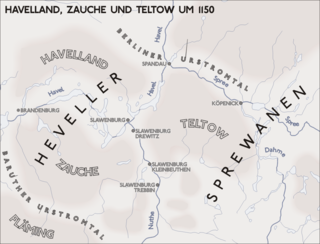
The Hevelli or Hevellians/ Navellasîni were a tribe of the Polabian Slavs, who settled around the middle Havel river in the present-day Havelland region of Brandenburg in eastern Germany from the 8th century onwards.

The West Slavs are Slavic peoples who speak the West Slavic languages. They separated from the common Slavic group around the 7th century, and established independent polities in Central Europe by the 8th to 9th centuries. The West Slavic languages diversified into their historically attested forms over the 10th to 14th centuries.

The Limes Saxoniae, also known as the Limes Saxonicus or Sachsenwall, was an unfortified limes or border between the Saxons and the Slavic Obotrites, established about 810 in present-day Schleswig-Holstein.
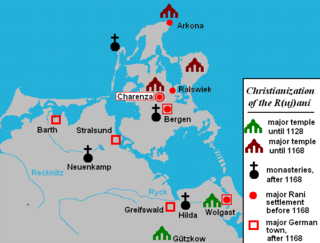
The Rani or Rujani were a West Slavic tribe based on the island of Rugia (Rügen) and the southwestern mainland across the Strelasund in what is today northeastern Germany.

Eldena Abbey, originally Hilda Abbey is a former Cistercian monastery near the present town of Greifswald in Mecklenburg-Vorpommern, Germany. Only ruins survive, which are well known as a frequent subject of Caspar David Friedrich's paintings, including the famous Abtei im Eichwald.

Pomerania during the High Middle Ages covers the history of Pomerania in the 12th and 13th centuries.

The Lutici or Liutizi(known by various spelling variants) were a federation of West Slavic Polabian tribes, who between the 10th and 12th centuries lived in what is now northeastern Germany. Four tribes made up the core of the federation: the Redarians, Circipanians (Circipani), Kessinians and Tollensians (Tholenzi). At least in part, the Lutici were a continuation of the Veleti. In contrast to the former and the neighboring peoples, the Lutici were not led by a Christian monarch or duke, rather power was asserted through consensus formed in central assemblies of the social elites, and the Lutici worshipped nature and several deities. The political and religious center was Radgosc.

In the Slavic revolt of 983, Polabian Slavs, Wends, Lutici and Obotrite tribes, that lived east of the Elbe River in modern north-east Germany overthrew an assumed Ottonian rule over the Slavic lands and rejected Christianization under Emperor Otto I.

Bavaria Slavica is a historiographic term used to denote the areas populated by West Slavic people (Wends) between the 6th and the 12th centuries in northeastern Bavaria. The Wends settled in Bavaria in several waves between the 6th and the 9th centuries and then in the 10th and the 11th centuries. The settlement of loyal West Slavic Wends and other minor tribes was favoured under Frankish Emperor Charlemagne. Later, the East Frankish Empire also settled largely-Christianized Wends in regions that were rural or unpopulated or threatened by uprisings. After the migration had ended, they were quickly assimilated by the local Franks, who had always continued to constitute the majority, and by the Baiuvarii.
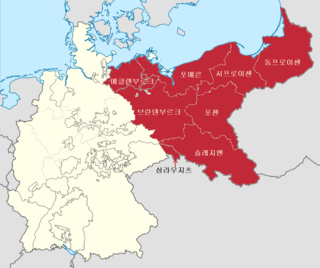
East Elbia was an informal denotation for those parts of the German Reich until World War II that lay east of the river Elbe.

Ostsiedlung is the term for the Early Medieval and High Medieval migration of ethnic Germans into the territories in the eastern part of Francia, East Francia, and the Holy Roman Empire and beyond; and the consequences for settlement development and social structures in the areas of settlement. Generally sparsely and in some inland areas only relatively recently populated by Slavic, Baltic and Finnic peoples, the most settled area was known as Germania Slavica. Other regions were also settled, though not as heavily. The Ostsiedlung encompassed multiple modern and historical regions such as Germany east of the Saale and Elbe rivers, the states of Lower Austria and Styria in Austria, Livonia, Poland, the Czech Republic, Slovakia, Slovenia, Hungary, and Transylvania in Romania.
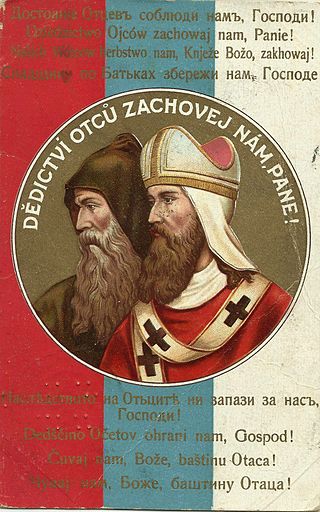
The Slavs were Christianized in waves from the 7th to 12th century, though the process of replacing old Slavic religious practices began as early as the 6th century. Generally speaking, the monarchs of the South Slavs adopted Christianity in the 9th century, the East Slavs in the 10th, and the West Slavs between the 9th and 12th century. Saints Cyril and Methodius are attributed as "Apostles to the Slavs", having introduced the Byzantine-Slavic rite and Glagolitic alphabet, the oldest known Slavic alphabet and basis for the Early Cyrillic alphabet.
The village of Flemmingen is one of the eleven components of the cultural landscape Naumburg Cathedral and the High Medieval Cultural Landscape of the Rivers Saale and Unstrut that has been proposed by the Federal Republic of Germany for inscription in the List of World Heritage. The World Heritage nomination is representative for the processes that shaped the continent during the High Middle Ages between 1000 and 1300: Christianization, the so-called “Landesausbau” and the dynamics of cultural exchange and transfer characteristic for this very period.

Sebastian Brather is a German medieval archaeologist and co-editor of Germanische Altertumskunde Online.
Tornow group, also known as Tornow-Klenica and Tornow-Gostyn in Poland, in archaeology refers to the Middle Slavic pottery and related strongholds of "Tornow-type" which were present in the middle of Obra, Oder, Spree but also Elbe and Saale basins from Greater Poland up to Thuringia. It is a derivation of Prague-Korchak, and dated since late 8th or early 9th century up to late 10th or early 11th century.
